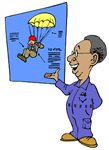|
||||||||
Writing Practice and Tools
Let's say you want to practice sequencing or writing directions. Ask students to complete a virtual activity. Then write the steps they followed. Younger students could recreate the experience with sequencing cards or real objects while older students might write paragraphs. Let's say you're looking for some quick extension activities that won't take much time. Use the following two web resources to stimulate writing.
|
||||||||
Writing Tools
As you explore online tools, consider what standards they will help you address. Also think about specific children in your classroom that might benefit from particular tools. | ||||||||
|
||||||||
Authentic Audiences
Check out Mr. Riley's Kindergarten Molecules in Motion page. How could you get your students involved in class writing projects using a blog? Check out the science author blog by an elementary class at Authorvisit. How could you connect with a member of the local, national, or international community? Go to Colorado Wildlife. These children created a website of all the animals in Colorado. Could you develop one for Pennsylvania? Go to Butterfly Garden. These children created a website on the topic of the Butterfly Garden. Could you create your own website related to a theme? Explore the projects produced by Mr. Leahy's Fifth Grade Class. How could you share the work of your children?
|
||||||||
Developed by Annette Lamb, 3/06. |
 Writing, Technology, & Differentiation
Writing, Technology, & Differentiation  Many online resources are available to stimulate writing ideas and practice writing skills. Seek out those that reinforce essential skills and expand thinking.
Many online resources are available to stimulate writing ideas and practice writing skills. Seek out those that reinforce essential skills and expand thinking.  Online tools are particularly useful for students who have trouble getting started with a blank piece of paper. They provide scenarios, prompts, ideas, and other tools to guide the writing process.
Online tools are particularly useful for students who have trouble getting started with a blank piece of paper. They provide scenarios, prompts, ideas, and other tools to guide the writing process. Design learning experiences that promote writing with a purpose.
Design learning experiences that promote writing with a purpose. Experiment!
Experiment!